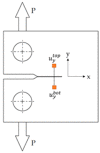New Plastic Crack-Tip Opening Displacement Tool Based on Digital Image Correlation for Estimating the Fatigue-Crack-Growth Law on 316L Stainless Steel
- PMID: 37444902
- PMCID: PMC10342813
- DOI: 10.3390/ma16134589
New Plastic Crack-Tip Opening Displacement Tool Based on Digital Image Correlation for Estimating the Fatigue-Crack-Growth Law on 316L Stainless Steel
Abstract
This work presents a new approach for studying crack growth resulting from fatigue, which utilizes the plastic contribution of crack-tip opening displacement (CTODp). CTODp is used to predict austenitic stainless-steel crack propagation. Unlike linear elastic fracture mechanics analysis, the method presented here is also helpful for tasks other than small-scale yielding. The approach was based on correlating full-field displacement information with post-processing digital images. This work describes a detailed post-processing protocol that can be used to calculate CTODp. The results for steel compact-tension specimens were especially promising. Of note, there was a linear relationship between the propagation rate of fatigue cracks and the CTODp range.
Keywords: crack-tip opening displacement; digital image correlation; fatigue crack propagation.
Conflict of interest statement
The authors declare no conflict of interest.
Figures



















References
-
- Nishida S. Failure analysis in engineering applications. Mater. Des. 1992;13:121.
-
- Burstow M.C., Howard I.C. Damage mechanics models of ductile crack growth in welded specimens. Fatigue Fract. Eng. Mater. Struct. 2000;23:691–708. doi: 10.1046/j.1460-2695.2000.00317.x. - DOI
-
- Findlay S.J., Harrison N.D. Why aircraft fail. Mater. Today. 2002;5:18–25. doi: 10.1016/S1369-7021(02)01138-0. - DOI
-
- Schütz W. A history of fatigue. Eng. Fract. Mech. 1996;54:263–300. doi: 10.1016/0013-7944(95)00178-6. - DOI
-
- Newman J.C., Phillips E.P., Swain M.H. Fatigue-life prediction methodology using small-crack theory. Int. J. Fatigue. 1999;21:109–119. doi: 10.1016/S0142-1123(98)00058-9. - DOI
Grants and funding
LinkOut - more resources
Full Text Sources

